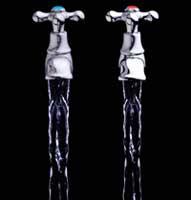It seems that it has begun to cool down...

Most do, but not all. Not everyone perceives the cold in the same way: some people are very germinated and others are always hot. That is, some already started to use winter clothes and others have not yet picked up the summer until next year.
It is clear that the terms heat and cold are very relative, they depend on the person who feels it and the situation. This can be demonstrated by a simple experiment often performed with children: we cushion three containers and fill one with hot water, another with cold water and the third with warm water. If we put one hand in hot water and the other in cold water, we will keep it for a little time and then we put both hands at once in warm water, with both hands we will not notice the feeling that the hand that has passed from cold water to temperate is hot, and that which has passed through hot water, which is cold.
The truth is that when two bodies at two temperatures (we have set the example of the human hand and water, but any other can be) come into contact, the one with the highest temperature passes heat to the coldest body to match the temperatures of both.
The human body is able to perceive small variations of temperature; it can perceive whether something is cold or hot with its temperature. However, objects can deceive our perception. If we enter a room cooler than body temperature and touch a metal on a table and a piece of wood, even if both are at the same temperature, it will seem to us that the metal is cooler than wood. This is because the metal is a good conductor (good temperature driver), so the metal "steals" the heat from the hand it touches, which gives us a feeling of cold. Wood is a very bad conductor and touching it with our hand "takes away" much less heat, so it seems to us that it is warmer.

Temperature in the street
When we go out on the street we can also see what the ambient temperature is. The temperature we perceive does not necessarily coincide with the actual temperature. For example, wind has a great influence on our perception. The body heats the surrounding air particles that bring heat to the body. However, if the wind blows (as long as the temperature of the street is colder than that of our body), that layer of air heated by the body disappears and the particle of air that is in contact with the body at every moment has to be heating constantly, which causes a feeling of cold. The higher the wind speed the greater the feeling of cold.
We must not forget, however, that temperature has a unique value in each of the circumstances mentioned, that our body feels what it feels. To know what temperature there is without subjectivity, therefore, it does not serve us. For this purpose man invented thermometers.
Published in 7K.
Buletina
Bidali zure helbide elektronikoa eta jaso asteroko buletina zure sarrera-ontzian











